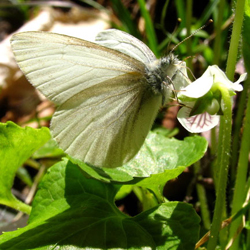Butterfly Atlas
Find a Butterfly
West Virginia White
Pieris virginiensis
Named
Edwards, 1870

Taxonomy & Nomenclature
Not consistently recognized as a distinct species until 1952. See discussion of the "napi complex" under Mustard White.
Identification
Wingspan: 1 3/8 - 1 5/8". Very similar to Mustard White, with which it is sometimes found in the spring. See Mustard White, for a full account of useful distinctions.
Distribution
Restricted to eastern North America from central Wisconsin and southern Ontario east to western New England, south through the Appalachians to northern Georgia. In New England the species occurs in southern Vermont and southwestern New Hampshire, Massachusetts west of the Connecticut River,and western Connecticut.
Status in Massachusetts
Uncommon to locally common in wooded areas mainly at higher elevations from the Connecticut Valley westward. Unlike the Mustard White, this species does not seem to have been subject to major population fluctuations due to the introduction of alien food plants, the Cabbage White, or other factors, though it too seems to be disappearing from known breeding areas in the Northeast (e.g. the lower Hudson valley fide Tudor pers com). Because its food plants (toothworts) are woodland species, it presumably declined as New England became substantially deforested in the 18th and 19th centuries and may have reoccupied parts of its former range with the ensuing reforestation. Unfortunately, Scudder and other early lepidopterists did not distinguish this species from the Mustard White, and therefore we have no way of corroborating these suppositions. Maximum: 12-15 at Hancock, Richmond, or Mt. Greylock (Berkshire Co.) from 5 May - 25 May.

Flight Period in Massachusetts
A single spring flight period from early April to late May. Extreme dates: 18 April 1987, Williamstown (Berkshire Co.), P. Weatherbee and 6 June 1988, New Ashford (Berkshire Co.), R. Laubach.
Larval Food Plants
In the wild, the West Virginia White feeds almost exclusively on toothworts (Cruciferae); recorded hosts include: Toothwort (Dentaria diphylla) and Cut-leaved Toothwort (D. laciniata). It has not been confirmed from the third New England Dentaria, Large Toothwort (D.maxima).
Adult Food sources
Apparently prefers the flowers of its foodplants, toothworts, but has also been recorded on other spring woodland wildflowers, e.g. Canada Violet, Wake Robin, and Garlic Mustard,(Opler and Krizek, 1984). Males also "drink" on streambanks and wet roads.

Habitat
Rich mesic deciduous or mixed forest where toothworts thrive. Unlike its close relative, the Mustard White, this species rarely strays from interior forest openings, trails, and edges.
Life Cycle
Very similar in known details to that of Mustard White. EGG: White to greenish yellow; spindle-shaped. OVIPOSITION: Eggs are laid singly on the underside of the food plant leaves. LARVA: Green with black dots at hair bases; pale-striped on top and sides with a short pile of fine hairs. CHRYSALIS: Light brown to blue gray or pale yellow to green with black dots, yellow stripes along top and sides; more slender than in Mustard White with a longer head "horn"; the chrysalis has been shown to be more like that of eastern North American forms of napi than like western or European forms. OVERWINTERING STAGE: Chrysalis.
Account Author
Chris Leahy



